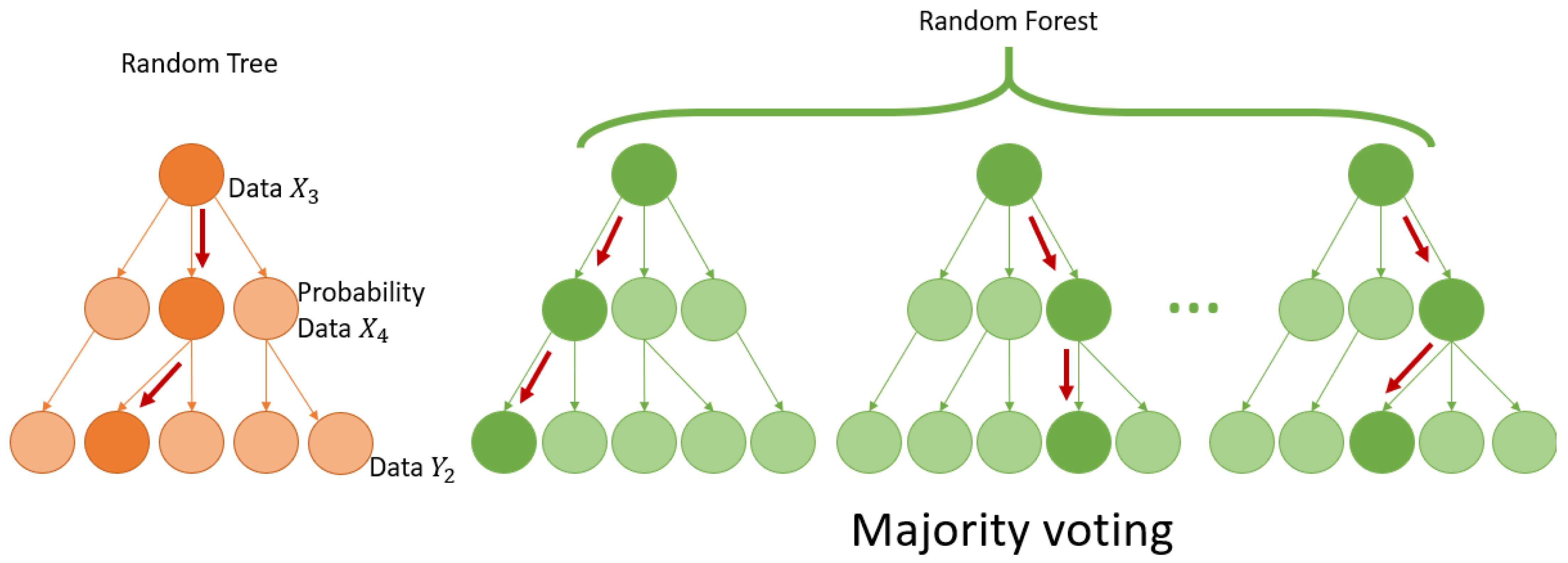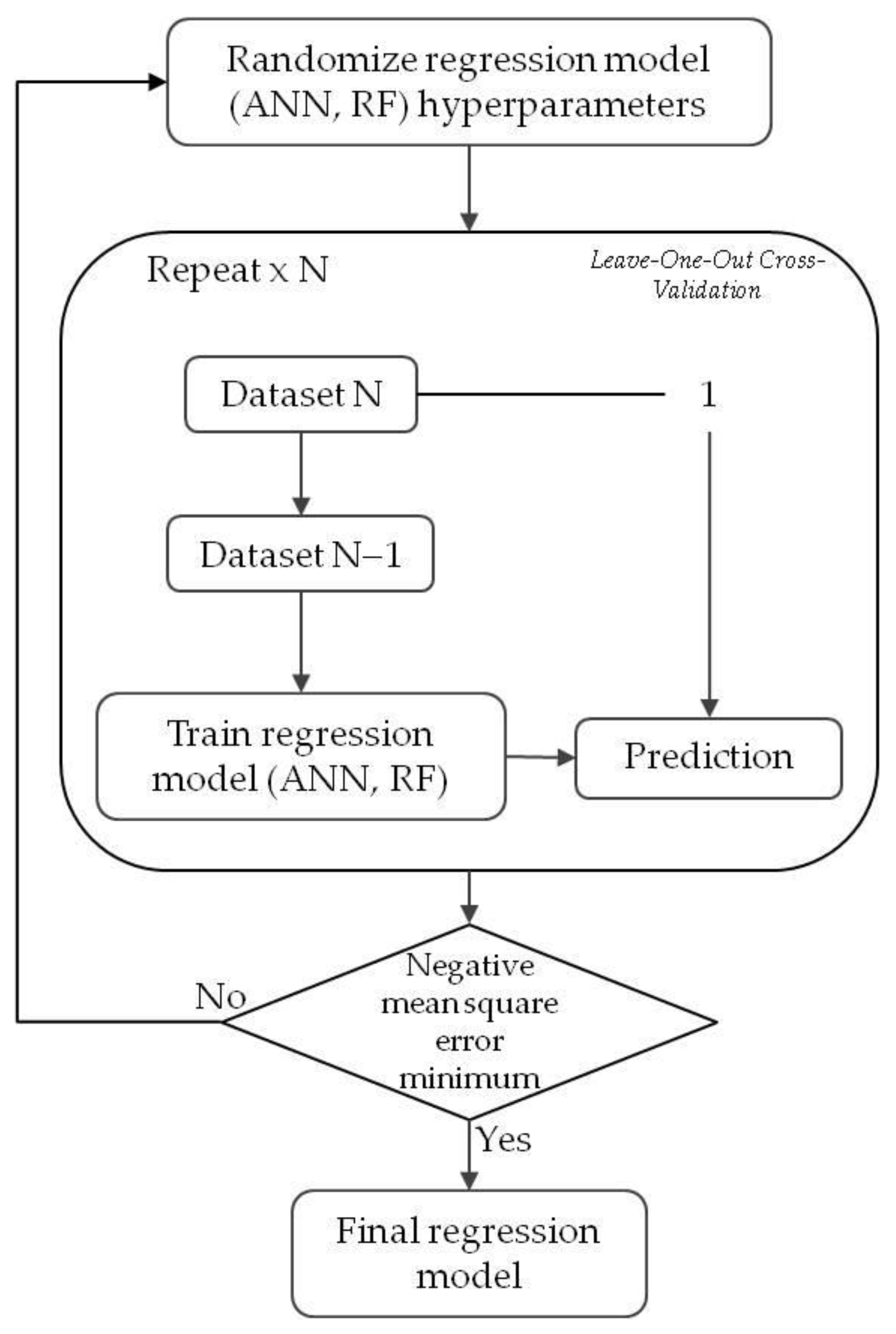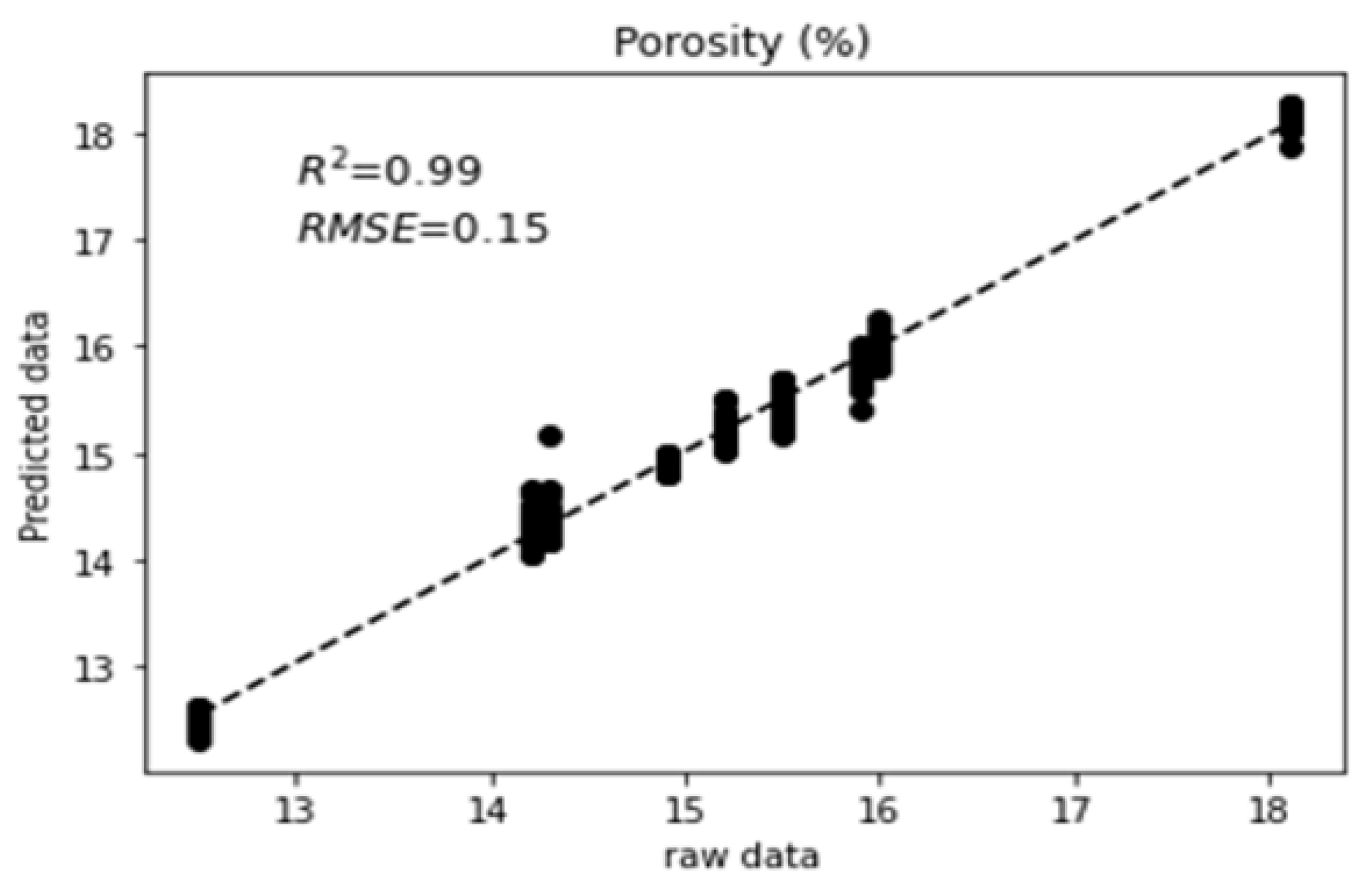Artificial Intelligence and Non-Destructive Testing Data to Assess Concrete Sustainability of Civil Engineering Infrastructures
Abstract
1. Introduction
- Destructive Testing (DT) generally consists of taking a sample from the infrastructure and testing it. The advantage is that it directly provides an outcome that matches the desired investigated properties. Tests for strength, like compressive strength testing, flexural strength testing, or twisting methods [3], are ‘direct’ measurements of the strength. DT is a reliable tool to investigate the infrastructure but contributes to the damage it seeks to measure. Moreover, once the measurement is performed, the sample cannot be reused to measure the evolution of the infrastructure. To assert a diagnosis without damaging the concrete, experts in the field must adopt a more subtle approach by examining the effects that lead to damage;
- Non-Destructive Testing (NDT) refers to the set of techniques available to track the health of the structure. Unlike DT, once the sensors are in place it allows multiple measurements in the same area and through time. Damage is limited as well, which is interesting for a continuous evaluation of the structure. However, NDT needs models of conversion to interpret the measurements into the properties of the structure. The standard EN 13791:2019, for instance, describes the procedure to evaluate strength with indirect methods by combining acoustic velocity with rebound method [4].
2. Materials and Methods
2.1. Experimental Dataset
- -
- Compressive strength of concrete denoted by Rc (MPa), which is the ultimate failure force applied on the concrete divided by the surface;
- -
- Degree of saturation denoted by Sr (%), which is the volume of water in the concrete divided by the volume of concrete pores;
- -
- Porosity denoted by Poro (%). which is volume of void in the concrete divided by the volume of the concrete;
- -
- Elastic modulus denoted by Estat (MPa), which is the derivative of the stress applied on the concrete with respect to the deformation for three cycles at the third of the rupture stress;
- -
- Density of concrete (kg/m).
| Types | Observables | Definition | Unit |
|---|---|---|---|
| Mechanical | MEC1 | Surface wave velocity in concrete depth (at frequency 1) | m/s |
| MEC2 | The surface wave velocity at a concrete (at frequency 2) | m/s | |
| MEC3 | The velocity when the two sensors are placed on two different sides of the concrete | m/s | |
| MEC4 | The vibration frequency using the Impact Echo method | Hz | |
| Electrical | ELE1 | Resistivity when electrodes are 5 cm apart | Ohm.m |
| ELE2 | Resistivity when electrodes are 10 cm apart | Ohm.m | |
| ELE3 | ELE1/ELE2 | Ø | |
| Electromagnetical | EM1 | Peak-to-peak amplitude of the received GPR signal | Ø |
| EM2 | The velocity of GPR waves | m/s | |
| EM3 | Time taken by a GPR wave to reach the receiving antenna at fixed distance 1 | ns | |
| EM4 | Time taken by a GPR wave to reach the receiving antenna at fixed distance 2 | ns |
2.2. Conversion Models
2.2.1. Random Forest (RF)
- Constructing a multiple decision tree using different smaller datasets that are randomly drawn from the original set;
- Obtaining predictions from each individual tree;
- Identifying the most commonly predicted class through a majority voting mechanism.

2.2.2. Artificial Neural Network (ANN)
- Input layer—this layer contains neurons responsible for receiving training data;
- Hidden layer(s)—one or more intermediate layers composed of neurons that perform mathematical transformations on the input data;
- Output layer—the final layer that provides the network’s predictions.
- The number of hidden layers;
- The number of neurons per hidden layer;
- The choice of activation functions (e.g., rectified linear, sigmoid, hyperbolic tangent, etc.)

3. Results and Discussion
- Randomly sampling a specified number of combinations of hyperparameters from the defined hyperparameter space;
- Training a model using the training data;
- Evaluating its performance using cross-validation.

3.1. Validation
3.2. Feature Importance Analysis and Local Explanation
3.3. Global Importance of Variables on the Prediction
4. Conclusions
- The obtained results demonstrate that both RF and ANN models can effectively predict concrete properties from NDT with high accuracy. The study highlights that, while ANN models provided the best performance for porosity predictions, RF models are better in predicting degree of saturation, elastic modulus, and density.
- A significant contribution of this work is the use of SHapley Additive exPlanations (SHAP) to interpret the models’ predictions, and trustworthiness of the Machine Learning models, and giving a reliable tool to optimize the number of sensors needed to make a satisfactory prediction. By integrating SHAP into AI using NDT on infrastructures, users can reduce their reliance on DT for more efficient predictive maintenance. This, in turn, would minimize damage and enable long-term monitoring.
- The results also demonstrate that a limited number of NDTs is actually sufficient for making a valid prediction, particularly regarding elasticity. AI can provide a prediction and its quality with a number of NDT that can be optimized using SHAP.
- The application of Machine Learning models in conjunction with NDT methods holds great promise for the future of civil engineering infrastructure maintenance. By leveraging data-driven insights and ensuring model explainability, stakeholders can make more informed decisions, ultimately contributing to the sustainability and resilience of our built environment.
Author Contributions
Funding
Institutional Review Board Statement
Informed Consent Statement
Data Availability Statement
Acknowledgments
Conflicts of Interest
References
- Maurey, H.; Chaize, P.; Dagbert, M. Sécurité des Ponts: Éviter un Drame. French Senate’s Report for the Commission De L’aménagement Du Territoire Et Du Développement Durable. 2019. Available online: https://www.senat.fr/rap/r18-609/r18-609.html (accessed on 6 March 2024).
- Balayssac, J.P.; Garnier, V. Non-Destructive Testing and Evaluation of Civil Engineering Structures; Elsevier: Amsterdam, The Netherlands; ISTE Press: London, UK, 2007; pp. 32–58. ISBN 978-178-548-229-8. [Google Scholar]
- Tomsett, H.N. Non-destructive testing of in situ concrete structures. NDT E Int. 1981, 14, 315–320. [Google Scholar] [CrossRef]
- NF EN-13791:2019; Assessment of In-Situ Compressive Strength in Structures and Precast Concrete Components. Technical Committee CEN/TC 104. European Committee for Standardization: Brussels, Belgium, 2019.
- Zadhoush, H.; Giannopoulos, A.; Giannakis, I. Optimising the Complex Refractive Index Model for Estimating the Permittivity of Heterogeneous Concrete Models. Remote Sens. 2021, 13, 723. [Google Scholar] [CrossRef]
- Fauchard, C.; Guilbert, V.; Sagnard, F.; Froumentin, M. Mesures de teneurs en eau volumique et massique sur du sable. Bull. Des Lab. Des Ponts Et Chaussées 2009, 274, 109–125. [Google Scholar]
- Alavi, S.A.; Noel, M.; Moradi, F.; Layssi, H. Development of a machine learning model for on-site evaluation of concrete compressive strength by SonReb. J. Build. Eng. 2024, 82, 108328. [Google Scholar] [CrossRef]
- Gunes, B.; Serkan, K.; Gunes, O. Drilling resistance testing combined with SonReb methods for nondestructive estimation of concrete strength. Constr. Build. Mater. 2023, 362, 129700. [Google Scholar] [CrossRef]
- Messaoudi, M.Z. Determinatión De Coordenadas De La Base De Calibración De La UPV. Ph.D. Thesis, Escuela Técnica Superior de Ingeniería Geodésica Cartográfica Y Topográfica, Madrid, Spain, July 2017. [Google Scholar]
- El-Mir, A.; El-Zahab, S.; Sbartaï, Z.M.; Homsi, F.; Saliba, J. Machine learning prediction of concrete compressive strength using rebound hammer test. J. Build. Eng. 2023, 64, 105538. [Google Scholar] [CrossRef]
- Breysse, D. Nondestructive evaluation of concrete strenght: An historical review and a new perspective by combining NDT methods. Constr. Build. Mater. 2012, 33, 139–163. [Google Scholar] [CrossRef]
- Masi, A.; Chiauzzi, L.; Manfredi, V. Criteria for identifying concrete homogeneous areas of in-situ strength in RC buildings. Constr. Build. Mater. 2016, 121, 576–582. [Google Scholar] [CrossRef]
- Guilbert, D.; Guan, B.; Ihamouten, A.; Villain, G.; Derobert, X. Linking degree of saturation with the complex dielectric permittivity of limestone in a GPR frequency band using SVR. IEEE Trans. Instrum. Meas. 2020, 70, 1–9. [Google Scholar] [CrossRef]
- Parsa, P.; Naderpour, H. Shear strength estimation of reinforced concrete walls using support vector regression improved by Teaching–learning-based optimization, Particle Swarm optimization, and Harris Hawks Optimization algorithms. J. Build. Eng. 2021, 44, 102593. [Google Scholar] [CrossRef]
- Asteris, P.G.; Karoglou, M.; Skentou, A.D.; Vasconcelos, G.; He, M.; Bakolas, A.; Zhou, J.; Armaghani, D.J. Predicting uniaxial compressive strength of rocks using ANN models: Incorporating porosity, compressional wave velocity, and Schmidt hammer data. Ultrasonics 2024, 141, 107347. [Google Scholar] [CrossRef]
- Ploix, M.A.; Garnier, V.; Breysse, D.; Moysan, J. Possibilistic NDT data fusion for evaluating concrete structures. AIP Conf. Proc. 2009, 9, 1307–1314. [Google Scholar] [CrossRef]
- Renoux, J.; Mouaddib, A.-I.; Le Gloannec, S. Distributed Decision—Theoretic Active Perception for Multi-robot Active Information Gathering. In Lecture Notes in Computer Science, 8825, Proceeding of the International Conference on Modeling Decisions for Artificial Intelligence, Tokyo, Japan, 29–31 October 2014; (MDAI 2014); Springer: Cham, Switzerland; New York, NY, USA.
- Yang, W.; Wei, Y.; Wei, H.; Chen, Y.; Huang, G.; Li, X.; Li, R.; Yao, N.; Wang, X.; Gu, X.; et al. Survey on explainable AI: From approaches, limitations and applications aspects. Hum. Centric Intell. Syst. 2023, 3, 161–188. [Google Scholar] [CrossRef]
- Tjoa, E.; Guan, C. A survey on explainable artificial intelligence (xai): Toward medical XAI. IEEE Trans. Neural Netw. Learn. Syst. 2021, 32, 4793–4813. [Google Scholar] [CrossRef]
- Sbartaï, Z.M.; Breysse, D.; Larget, M.; Balayssac, J.P. Combining NDT techniques for improved evaluation of concrete properties. Cem. Concr. Compos. 2012, 34, 725–733. [Google Scholar] [CrossRef]
- Lundberg, S.M. A Unified Approach to Interpreting Model Predictions. Available online: https://proceedings.neurips.cc/paper/2017/hash/8a20a8621978632d76c43dfd28b67767-Abstract.html (accessed on 6 March 2024).
- Lataste, J.F.; Villain, G.; Balayssac, J.P. Electrical Methods. In Non-Destructive Testing and Evaluation of Civil Engineering Structures; Elsevier: Amsterdam, The Netherlands; ISTE Press: London, UK, 2007; pp. 172–192. ISBN 978-178-548-229-8. [Google Scholar]
- Derobert, X.; Villain, G.; Balayssac, J.P. Influence of Concrete Carbonation on Electromagnetic Permittivity Measured by GPR and Capacitive Techniques. J. Environ. Eng. Geophys. 2018, 23, 443–456. [Google Scholar] [CrossRef]
- Klysz, G. Caractérisation Du Béton D’enrobage Par Technique Radar: Exploitation De L’onde Directe Emetteur-Récepteur. Ph.D. Thesis, Université Toulouse Paul Sabatier, Toulouse, France, 2004. [Google Scholar]
- Garnier, V.; Piwakowski, B.; Abraham, O.; Villain, G.; Payan, C.; Chaix, J.F. Acoustic techniques for concrete evaluation: Improvements, comparisons and consistency. Constr. Build. Mater. 2013, 43, 598–613. [Google Scholar] [CrossRef]
- Villain, G.; Sbartaï, Z.M.; Derobert, X.; Balayssac, J.-P. Durability diagnosis of a concrete structure in tidal zone by combining NDT methods: Laboratory tests and case study. Constr. Build. Mater. 2012, 37, 893–903. [Google Scholar] [CrossRef]
- Hastie, T.; Tibshirani, R.; Friedman, J. Data mining, inference, and prediction. In The Elements of Statistical Learning Springer Series in Statistics; Springer: New York, NY, USA, 2009. [Google Scholar]
- Alloghani, M.; Al-Jumeily, D.; Mustafina, J.; Hussain, A.; Aljaaf, A.J. A systematic review on supervised and unsupervised machine learning algorithms for data science. In Supervised and Unsupervised Learning for Data Science; Berry, M., Mohamed, A., Yap, B., Eds.; Springer: Cham, Switzerland; New York, NY, USA, 2020; pp. 3–21. ISBN 978-3-030-22474-5. [Google Scholar]
- Sun, J.; Zhang, J.; Gu, Y.; Huang, Y.; Sun, Y.; Ma, G. Prediction of permeability and unconfined compressive strength of pervious concrete using evolved support vector regression. Constr. Build. Mater. 2019, 207, 440–449. [Google Scholar] [CrossRef]
- Bielza, C.; Larranaga, P. Discrete Bayesian network classifiers: A survey. ACM Comput. Surv. (CSUR) 2014, 47, 1–43. [Google Scholar] [CrossRef]
- Trinchero, R.; Canavero, F. Machine learning regression techniques for the modeling of complex systems: An overview. IEEE Electromagn. Compat. Mag. 2021, 10, 71–79. [Google Scholar] [CrossRef]
- Malhotra, R.; Cherukuri, M. A systematic review of hyperparameter tuning techniques for software quality prediction models. Intell. Data Anal. 2024, 28, 1131–1149. [Google Scholar] [CrossRef]
- Yang, L.; Shami, A. On hyperparameter optimization of machine learning algorithms: Theory and practice. Neurocomputing 2020, 415, 295–316. [Google Scholar] [CrossRef]
- Breimann, L.; Friedmann, J.H.; Olshen, R.A.; Stone, C.J. Classification and Regression Trees, 1st ed.; Taylor & Francis: New York, NY, USA; CRC Press: Wadsworth, OH, USA, 1984; ISBN 978-041-204-841-8. [Google Scholar]
- Breimann, L. Random Forest. Mach. Learn. 2001, 45, 5–32. [Google Scholar] [CrossRef]
- Probst, P.; Wright, M.N.; Boulesteix, A.L. Hyperparameters and tuning strategies for random forest. Wiley Interdiscip. Rev. Data Min. Knowl. Discov. 2019, 9, e1301. [Google Scholar] [CrossRef]
- Al Bataineh, A.; Manacek, S. MLP-PSO Hybrid Algorithm for Heart Disease Prediction. J. Pers. Med. 2022, 12, 1208. [Google Scholar] [CrossRef] [PubMed]
- Mirjalili, S. Evolutionary multi-layer perceptron. In Studies in Computational Intelligence; Springer: New York, NY, USA, 2019; Volume 780, pp. 87–104. ISBN 978-3-319-93024-4. [Google Scholar] [CrossRef]
- Rojas, M.G.; Olivera, A.C.; Vidal, P.J. A genetic operators-based Ant Lion Optimiser for training a medical multi-layer perceptron. Appl. Soft Comput. 2024, 151, 111–192. [Google Scholar] [CrossRef]
- Dauji, S. Comparaison of NDT Data Fusion for Concrete Strength using Decision Tree and Artificial Neural Network. J. Sci. Ind. Res. 2023, 82, 831–840. [Google Scholar] [CrossRef]
- Bergstra, J.; Bengio, Y. Random search for hyper-parameter optimization. J. Mach. Learn. Res. 2012, 13, 281–305. [Google Scholar]
- Wong, T.T. Performance evaluation of classification algorithms by k-fold and leave-one-out cross validation. Pattern Recognit. 2015, 48, 2839–2846. [Google Scholar] [CrossRef]
- Ying, X. An Overview of Overfitting and its Solutions. J. Phys. Conf. Ser. 2019, 1168, 022022. [Google Scholar] [CrossRef]







| Variables | |||||||||
|---|---|---|---|---|---|---|---|---|---|
| Porosity (%) | Sr (%) | Elastic Modulus (MPa) | |||||||
| Models | RMSE | NRMSE | RMSE | NRMSE | RMSE | NRMSE | |||
| ANN | 0.15 | 2.5% | 0.99 | 6.28 | 9% | 0.77 | 1868.6 | 5.7% | 0.93 |
| RF | 0.24 | 4% | 0.97 | 1.98 | 2.8% | 0.98 | 923.08 | 2.8% | 0.98 |
| Variables | |||||||||
| Rc (MPa) | Density () | ||||||||
| Models | RMSE | NRMSE | RMSE | NRMSE | |||||
| ANN | 1.5 | 2.5% | 0.99 | 0.01 | 6.5% | 0.97 | |||
| RF | 1.78 | 3% | 0.98 | 0.01 | 6.5% | 0.98 | |||
| Porosity (%) ANN | |||
|---|---|---|---|
| Observables | RMSE | NRMSE | |
| (MEC1, MEC2, MEC3, MEC4, ELE1, ELE2, ELE3, EM1, EM2, EM3, EM4) | 0.15 | 2.5% | 0.99 |
| (MEC1, MEC2, MEC3, MEC4, EM2, EM3) | 0.23 | 3.83% | 0.95 |
| (MEC1, MEC2, MEC3, MEC4, EM3) | 0.35 | 5.83% | 0.88 |
| (MEC1, MEC3, MEC4, EM3) | 0.41 | 6.83% | 0.83 |
| (MEC1, MEC3, MEC4) | 0.47 | 7.83% | 0.77 |
| Rank Contribution | Porosity (%) ANN | Rc (MPa) ANN | Sr (%) RF | Elastic Modulus (MPa) ANN | RF | |
|---|---|---|---|---|---|---|
| Mechanical | MEC1 | 2 | 1 | 9 | 7 | 5 |
| MEC2 | 5 | 4 | 10 | 8 | 3 | |
| MEC3 | 3 | 5 | 8 | 1 | 1 | |
| MEC4 | 1 | 3 | 11 | 4 | 2 | |
| Electrical | ELE1 | 9 | 6 | 7 | 3 | 7 |
| ELE2 | 10 | 11 | 6 | 11 | 8 | |
| ELE3 | 7 | 10 | 2 | 9 | 10 | |
| Electromagnetic | EM1 | 8 | 7 | 5 | 5 | 11 |
| EM2 | 6 | 8 | 4 | 2 | 9 | |
| EM3 | 4 | 2 | 3 | 10 | 4 | |
| EM4 | 11 | 9 | 1 | 6 | 6 | |
Disclaimer/Publisher’s Note: The statements, opinions and data contained in all publications are solely those of the individual author(s) and contributor(s) and not of MDPI and/or the editor(s). MDPI and/or the editor(s) disclaim responsibility for any injury to people or property resulting from any ideas, methods, instructions or products referred to in the content. |
© 2025 by the authors. Licensee MDPI, Basel, Switzerland. This article is an open access article distributed under the terms and conditions of the Creative Commons Attribution (CC BY) license (https://creativecommons.org/licenses/by/4.0/).
Share and Cite
Baudrit, C.; Dufau, S.; Villain, G.; Sbartaï, Z.M. Artificial Intelligence and Non-Destructive Testing Data to Assess Concrete Sustainability of Civil Engineering Infrastructures. Materials 2025, 18, 826. https://doi.org/10.3390/ma18040826
Baudrit C, Dufau S, Villain G, Sbartaï ZM. Artificial Intelligence and Non-Destructive Testing Data to Assess Concrete Sustainability of Civil Engineering Infrastructures. Materials. 2025; 18(4):826. https://doi.org/10.3390/ma18040826
Chicago/Turabian StyleBaudrit, Cédric, Sylvain Dufau, Géraldine Villain, and Zoubir Mehdi Sbartaï. 2025. "Artificial Intelligence and Non-Destructive Testing Data to Assess Concrete Sustainability of Civil Engineering Infrastructures" Materials 18, no. 4: 826. https://doi.org/10.3390/ma18040826
APA StyleBaudrit, C., Dufau, S., Villain, G., & Sbartaï, Z. M. (2025). Artificial Intelligence and Non-Destructive Testing Data to Assess Concrete Sustainability of Civil Engineering Infrastructures. Materials, 18(4), 826. https://doi.org/10.3390/ma18040826








